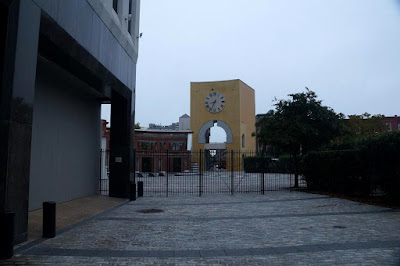"Charles Moore’s Piazza d’Italia is like one of those fruity, rummy Hurricane cocktails that you sip through a straw from a curvy glass garnished with an orange slice and maraschino cherry: colorful, over the top, and made of questionable ingredients." (Freeman, 2004)
"The way architecture communicates with this industrial society has to be seen as a major challenge for Post-Modernism. Clearly Modernism failed to speak to this society in several ways [...]. Simplifying somewhat we can point to three basic justifications for choosing a style, or mixing them, as the case may be: the context that the building fits into, the character of the particular functions which must be enhanced by style, and the taste-culture of the inhabitants. We can see these three aspects in Charles Moore's [...] Piazza d'Italia in New Orleans" (Jencks, 1977, p. 143)
"Inclusivism rejects the Modern Movement's aloof and heroic stance with regards to the realities of day-to-day living in favor of a more modest and flexible position by which architecture embodies values that are supported by society and not just other architects. [...]
Post-Modernism also rejects the abstraction of the Modern movement's International Style in favor of a return to "representational" as a key element in communication. Charles Moore, for example, states that his recent design for a fountain at the Piazza d'Italia in New Orleans is 'shaped like the map of Italy (only very slightly abstracted), with the five architectural orders on the wall surruonding it rendered, not exactly standardly, but certainly quite specifically in stainless steel and water [...]'" (Stern, 2009, p. 111)
"A point worth stressing is that the plurality of meanings in this scheme could not have been successfully incorporated by one designer (a point to be made generally about participation [...]). Moore has teamed up with two local architects from the firm of Perez and Associates and these designers supplied much of the peculiar cultural knowledge. They were the ones to stress the importance of the annual St. Joseph's festival, the pretext for the fountain and piazza. Once a year, the Italian community comes to the fore to celebrate its presence and they do so by selling Italian specialities and local concoctions (muffalattas, salami, cheese, etc.) on the day of their patron saint. Since the ostensible reason for the piazza was to give identity to the Itallian community in a city where other ethnic groups dominate (the French, Spanish, the blacks and Anglos) there was a sufficient pretext for historicist rhetoric and explicit content." (Jencks, 1977, p. 146)
"Clearly, the success of this rhetoric depends on an area outside of architecture: the belief in a credible social or metaphysical content. The search for such content is the next challenge for Post-Modernists." (Jencks, 1977, p. 146).
Fuentes:
Freeman, A. (2004) "That ’70s Show. In New Orleans, the third act begins on a famous outdoor stage." Landscape Architecture.
Jencks, C. (1977) The Language of Post-Modern Architecture. New York: Rizzoli.
Stern, R. A. M. (2009) Architecture on the edge of Post Modernism. Collected Essays 1964-1988. New Haven: Yale University Press.
















